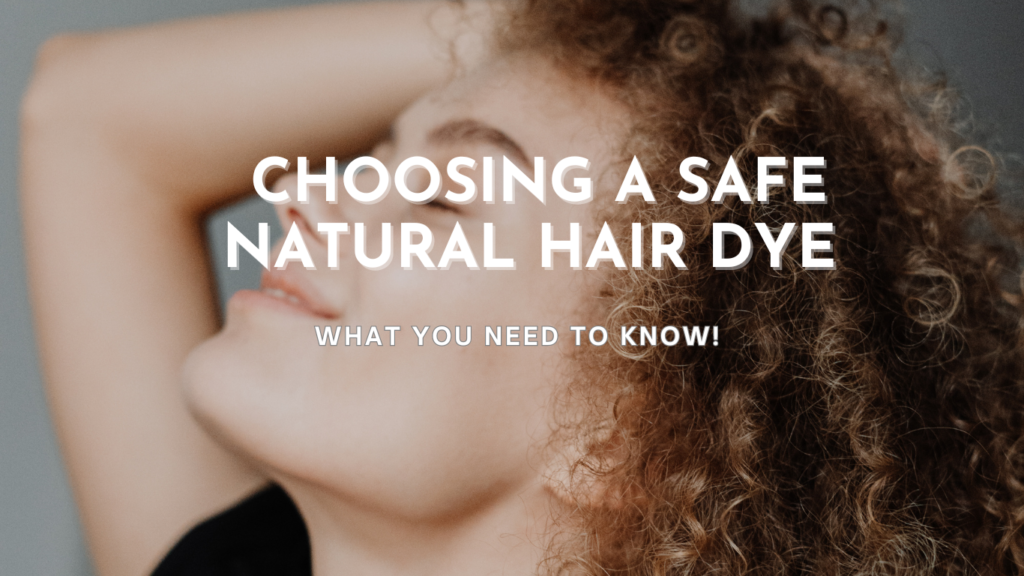Avoid Toxic Chemicals in Hair Dyes: Learn to Color Your Hair Safely
Many conventional hair dyes contain harmful chemicals that can pose risks to your health. However, there are safer, non-toxic alternatives available for those who want to color their hair without exposure to these dangerous substances. In this comprehensive guide, we’ll explore how to safely color your hair while avoiding the toxic ingredients found in most commercial hair dyes, along with tips and alternative options for healthier, vibrant hair color.
 Why Avoid Toxic Chemicals in Hair Dye?
Why Avoid Toxic Chemicals in Hair Dye?
Traditional hair dyes often contain a cocktail of harsh chemicals that can have significant short- and long-term effects on your health. These include common irritants like ammonia, PPD (p-phenylenediamine), and resorcinol, which not only contribute to allergic reactions but may also pose a risk of more severe health problems, such as cancer, respiratory issues, and hormonal imbalances. Given the regularity with which many people color their hair, the cumulative exposure to these chemicals can become concerning over time.
Health Risks of Toxic Hair Dyes
One of the primary concerns with conventional hair dyes is that they can lead to allergic reactions. Some people develop contact dermatitis from the harsh chemicals, resulting in symptoms like itching, redness, and swelling around the scalp, neck, and ears. The allergic reactions can range from mild discomfort to severe anaphylactic reactions, which can be life-threatening in rare cases.
Beyond skin sensitivities, there is also growing evidence that frequent use of toxic hair dyes may increase the risk of respiratory issues. Chemicals like ammonia and formaldehyde-releasing agents can irritate the respiratory tract, particularly in poorly ventilated areas, leading to symptoms such as coughing, shortness of breath, and asthma flare-ups in susceptible individuals.
Additionally, there have been links between prolonged exposure to these toxic substances and more serious long-term health concerns. Some studies have suggested a potential association between regular hair dye use and an increased risk of bladder cancer and breast cancer. While more research is needed to establish a definitive connection, the possible health implications are enough to warrant caution when choosing hair dyes.
Common Toxic Ingredients in Hair Dyes to Avoid
If you’re concerned about the chemicals in your hair dye, it’s important to become familiar with the most common toxic ingredients to avoid. Understanding what’s in your hair products can help you make better choices for your health and safety.
1. Ammonia
Ammonia is one of the most widely used chemicals in hair dyes, as it helps open the hair cuticle to allow the color to penetrate more effectively. However, ammonia is known to cause scalp irritation, and over time, it can severely damage your hair’s natural structure, leaving it dry, brittle, and prone to breakage. Inhalation of ammonia fumes can also lead to respiratory issues, making it particularly problematic for individuals with pre-existing respiratory conditions like asthma.
2. PPD (p-phenylenediamine)
PPD is another common ingredient in hair dyes, especially in darker shades, due to its ability to create a more long-lasting color. However, PPD is a known allergen that has been linked to contact dermatitis and other allergic reactions. It’s also a suspected carcinogen, meaning it could potentially contribute to cancer development with prolonged exposure.
3. Resorcinol
Resorcinol is often used in combination with PPD in hair dyes to help stabilize the color. However, this chemical can interfere with your endocrine system, which is responsible for regulating hormone levels. Disruptions in this system can lead to hormonal imbalances, which may affect reproductive health and other bodily functions.
4. Parabens and Phthalates
These chemicals are commonly used as preservatives and fragrance enhancers in hair products, including dyes. Parabens have been linked to disruptions in hormone function, while phthalates have been associated with reproductive health issues. Both of these chemicals are known endocrine disruptors, meaning they can interfere with the normal functioning of your hormones, potentially leading to health issues over time.
By avoiding these harmful chemicals, you can significantly reduce your exposure to toxins and protect both your short- and long-term health.
Safer Alternatives for Hair Coloring
Luckily, you don’t have to sacrifice beautiful hair color in order to avoid these harmful chemicals. There are several natural and non-toxic alternatives that can give you the vibrant color you desire without compromising your health.
1. Herbal Hair Dyes
Herbal hair dyes are an excellent option for those looking to avoid toxic chemicals altogether. Popular herbal dyes include henna, indigo, and cassia, all of which are derived from plants. These natural dyes provide a chemical-free way to color your hair while also conditioning and nourishing it. Henna is particularly well-known for creating vibrant red tones, while indigo can give you darker shades. Cassia is ideal for lighter, golden hues.
The benefit of herbal dyes is that they don’t contain the harsh chemicals found in conventional hair dyes, making them a safer choice for those with sensitive skin or allergies. However, keep in mind that the results of herbal dyes can vary depending on your natural hair color and the specific mixture of herbs used.
2. Ammonia-Free Hair Dyes
For those who prefer a more traditional hair dye experience but want to avoid ammonia, there are now plenty of ammonia-free hair dyes on the market. These dyes use gentler alternatives to ammonia that are less likely to cause irritation or damage to your hair. While ammonia-free dyes may not penetrate the hair as deeply as those containing ammonia, they still offer long-lasting results with less damage to your hair and scalp.
Look for brands that prioritize safer ingredients and avoid common irritants like PPD and resorcinol. Many of these brands also offer vegan and cruelty-free options, making them a great choice for conscious consumers.
3. Temporary and Semi-Permanent Dyes
If you’re looking for a temporary change or just want to experiment with different colors, temporary or semi-permanent dyes are a safer alternative to permanent dyes. These products typically contain fewer harmful chemicals and wash out after several washes, making them a good option for those who want to avoid a long-term commitment. Because they don’t penetrate the hair shaft as deeply, they are less likely to cause damage or irritation.
 Tips for Coloring Your Hair Safely
Tips for Coloring Your Hair Safely
No matter what type of dye you choose, there are several steps you can take to ensure a safer hair coloring experience:
– Patch Test First: Always do a patch test before using any hair dye to check for allergic reactions. Apply a small amount of dye to a patch of skin, usually behind your ear or on your inner arm, and wait 48 hours to see if any reaction occurs.
– Use Gloves and Proper Ventilation: When applying dye, make sure to wear gloves to protect your hands from chemicals. It’s also important to apply dye in a well-ventilated area to minimize your exposure to potentially harmful fumes.
– Go to a Professional: If you’re unsure about using natural dyes or are concerned about safety, it’s a good idea to visit a professional hair salon that specializes in organic or natural hair coloring. A trained stylist can help you choose the best products and techniques for your hair.
– Condition and Protect Your Hair: Before and after coloring, use deep-conditioning treatments to protect your hair from damage and keep it hydrated. Natural oils like coconut or argan oil can also help strengthen and nourish your hair, especially after using hair dye.
Final Thoughts on Safe Hair Coloring
Switching to non-toxic hair dyes can have a positive impact on both your health and the environment. By opting for natural or safer alternatives, you significantly reduce your exposure to harmful chemicals while still achieving beautiful, vibrant hair color. Always take the time to research the ingredients in your hair products and choose brands that prioritize safety and sustainability.
In addition to protecting your own health, using non-toxic hair dyes is also better for the planet. Many toxic chemicals in conventional dyes can end up in our waterways, harming aquatic life and ecosystems. By choosing safer alternatives, you’re not only doing your part to protect your health but also contributing to a more eco-friendly beauty routine.
Remember, the health of your hair and scalp is just as important as how it looks. By making informed choices, you can enjoy the benefits of beautiful hair color without the risk of exposure to harmful chemicals. Stay safe, and color your hair with confidence!
The Article Tips to Choosing The Right Natural Hair Dye First Appeared ON
: https://ad4sc.com
The Article Tips to Choosing The Right Natural Hair Dye Was Found On https://limitsofstrategy.com


This topic really resonates with me. A few years back, I made the switch to using natural hair dyes after experiencing some allergic reactions to conventional brands. It was surprising to learn just how many harsh chemicals are hidden in products we use regularly. Since transitioning to non-toxic options, I’ve not only noticed a reduction in irritation but also feel more at ease knowing I’m making a healthier choice for my body.
Ah, the age-old dilemma of hair color—it’s like a relationship, isn’t it? A little excitement, a little risk, and the potential for a long-term commitment to a shade that may or may not jump off the top of your head and distract strangers on the street. But as you’ve brilliantly pointed out, the factors that make up that decision are way more crucial than just whether we can pull off “chestnut brown” without looking like a human nutmeg.
You bring up such an interesting point about hair color being akin to a relationship. It really does mirror the balance of excitement and risk, doesn’t it? I once decided to go from dull black to a vibrant purple, thinking it would spark some joy and creativity. It definitely turned heads—and not always for the reasons I anticipated. There’s that fine line between a confident “I own this” and a hesitant “Did I just make a huge mistake?”
Speaking of bold choices, planning a trip can be just as thrilling—like deciding whether to go adventurous with your hair or stick to the classics; take a look at this piece on the unexpected escapades waiting in rural Belize City, where every turn offers a splash of color and charm.
‘Exciting Adventures Await in Rural Belize City’
https://ishevents.org/exciting-adventures-await-in-rural-belize-city/.
You’ve really captured the essence of how a simple change, like hair color, can evoke such a complex mix of feelings. I think that balance between confidence and doubt is something many of us can relate to—it’s so human to seek out excitement while fearing the judgment that might come along with it. Your transition to vibrant purple sounds both bold and liberating, even if the reactions were mixed. It reminds me of how personal expression often walks that tightrope between self-assertion and vulnerability.
You’ve captured the whimsical nature of hair color choices perfectly. It’s fascinating how a simple decision like dyeing our hair can reflect so much about who we are or how we’re feeling at a given time. Just like relationships, the journey often involves experimenting with different shades, each carrying its own meaning and memories.
I really appreciate this exploration of non-toxic hair dye alternatives! It’s so important to be aware of what we’re putting on our bodies, especially when it comes to something like hair color, which we often treat as just a quick cosmetic change. I recently made the switch to natural dyes myself after experiencing some irritation from conventional products. It was eye-opening to research just how many harmful chemicals lurk in standard hair dyes.
It’s refreshing to see a conversation around the impact of hair dye ingredients gaining more attention. Personally, I made the switch to natural hair dye a couple of years ago after experiencing some alarming reactions to conventional products. It’s incredible how much better my scalp and overall health felt once I ditched those toxic chemicals.
Ah, the colorful world of hair dye! It’s a fascinating journey we undertake to transform our luscious locks, isn’t it? Sometimes it feels less like a beauty ritual and more like a chemistry experiment gone wrong. I can’t help but chuckle at my early hair dye attempts—who knew that attempting a bold crimson color would remind me of the aftermath of a paintball match? Those poor bathroom tiles have seen things!